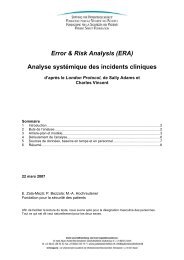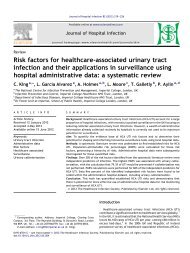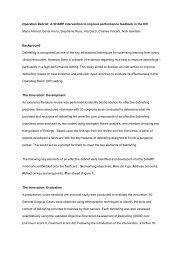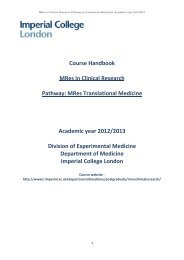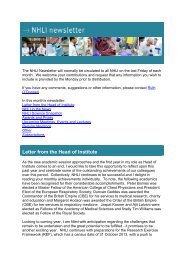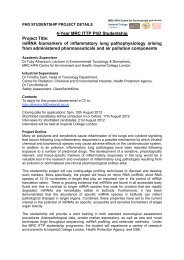QOF Plus Year 1 - Imperial College London
QOF Plus Year 1 - Imperial College London
QOF Plus Year 1 - Imperial College London
Create successful ePaper yourself
Turn your PDF publications into a flip-book with our unique Google optimized e-Paper software.
Specific reasons for this framework are:1 A minimum data quality standard is required to accurately validate work done for <strong>QOF</strong>+.2 Incentives for specific disease areas may have a detrimental effect on other areas ofclinical management that are not covered by these incentives. Minimum standards indata quality can be applied across a wider range of health domains, which will encouragemore standardisation of care in areas not incentivised by current the <strong>QOF</strong> or <strong>QOF</strong>+schemes.3 There are a number of disease areas, with a high burden of disease, which are notrewarded through <strong>QOF</strong> or <strong>QOF</strong>+. Improving data standards will raise the profile of theseareas.4 Improving existing data quality will allow practices and the PCT to be more effective atpro-actively finding ‘at-risk’ patient groups and so aid health promotion and prevent illhealth.Specific examples are recording details of exercise habits and dietary status (inthe future).5 High quality data will also allow better monitoring of health inequalities across the PCTthat is known to have a diverse ethnic and socio-economic population mix.6 High quality primary care data across Hammersmith and Fulham will enable audit thataccurately describes current clinical practice and the population being served. This will inturn allow better service planning and commissioning, and identification of educationand training needs.High quality electronic data from general practices is an essential element for the Hammersmithand Fulham <strong>QOF</strong>+ financial incentive scheme. This proposed framework requires all practices tohave electronic patient records and to use them as their default medical record system. Anelectronic record allows relatively easy and accurate searching for the purposes of audit andverification, as well as being used as a tool to identify at risk groups quickly. Without an electronicrecord the intended outcomes of the <strong>QOF</strong>+ incentive scheme are less likely to be achieved.Data standards matching or exceeding the requirements of each indicator in this framework willlead to a payment. Each indicator is an ‘all or nothing’ payment according to whether a practicereaches a certain standard, and so they are not designed to be unattainable since this maydiscourage the transformational improvement in practice that the <strong>QOF</strong>+ scheme will require. Infact, full attainment of year 1 targets is ultimately desirable, both to drive up data standards andto achieve ‘buy-in’ to the scheme from general practices on the understanding that targets willrise in future years in a continual drive for improvement.Review of evidence to support the proposed indicatorsThe standards set for each indicator of quality are designed to be challenging, with the aim ofincrementally raising the bar in each successive year of the scheme. This process of tangiblefinancial reward and feedback of results has been described as best practice in any effectiveprimary care data quality programme (De Lusignan and Teasdale, 2004).60



